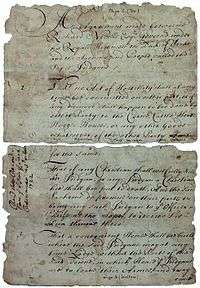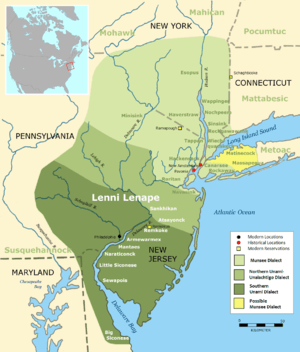Esopus people
The Esopus tribe (es-SOAP-es)[1] is a tribe of Lenape (Delaware) Native Americans who were native to what is now Upstate New York, specifically the region of the Catskill Mountains. Their lands included modern-day Ulster and Sullivan counties. The Lenape originally resided in the Delaware River Valley before their territory extended into parts of modern-day New York (including the Catskill Mountains and Lower Hudson River Valley), Pennsylvania, New Jersey, and Eastern Delaware. The exact population of the Lenape is unknown but estimated to have been around 10,000 people in 1600.[2] The Esopus people spoke an Algonquin dialect known as Munsee.


The tribe generally lived in small communities consisting of 10-100 people. They traveled seasonally and settled mostly in clearings by sources of water, developing diverse agricultural practices. The Esopus people's main crop was corn, but also planted or foraged beans, squash, hickory, nuts, and berries in addition to hunting elk, deer, rabbits, turkey, raccoons, waterfowl, bears, and fish. They generally ate two meals a day according to what was seasonally available.[3]
Socially, the Esopus people traditionally had strict heterosexual marriages with rules to prevent inter-breeding. The average lifespan was generally 35–40 years old. Sachems or chiefs were temporary power holders meant to make decisions based on the well-being of the tribe, and although there were definite gendered roles within the tribal community, there was no sense of patriarchal structure.[4]
History
Esopus Wars
The first believed interaction between colonists and the Esopus people was recorded in 1609. The Esopus tribe sold 72 acres of land to European colonists in 1652 through the Thomas Chambers land deed in Kingston, New York. It is unknown whether the two Esopus sachems at the time, Kawachhikan and Sowappekat, understood the transaction, as their communities had foundational differences in understanding money, ownership, and transactions (along with a language barrier). This deed began the following centuries of dispossession continued through the Fisher/Rutgers Land Deed of 1899 and the Peter Stuyvesant Blockade.[5]
The tribe fought a series of conflicts against settlers from the New Netherland colony from September 1659 to September 1663, known as the Esopus Wars, in and around Kingston, New York. At the conclusion of the conflict, the tribe sold large tracts of land to French Huguenot refugees in New Paltz and other communities.[6]
The Esopus Wars devastated many Lenape communities in what is now Ulster County. Populations dwindled through warfare with Dutch and French settlers, in addition to widespread disease, with smallpox being the most deadly. Casualties were exacerbated by inter-tribal warfare.[7]
Esopus people today
After the Esopus wars, many Stockbridge-Munsee moved to Western New York near Oneida Lake. They were eventually pushed off these lands by the Indian Removal Treaties in the 1800s, eventually forced to settle on “inhospitable land” in Wisconsin by the 1830s.[8]
Today, descendants of the Esopus now live on the Stockbridge-Munsee Community reservation in Shawano County, Wisconsin and among the Munsee Delaware of Ontario, Canada. Historians believe some Esopus joined with some Wappinger people after Kieft's War in 1643.[9]
See also
References
- considering the title of "An Agreement made between Richard Nicolls Esq. Governor under his Royal Highness the Duke of Yorke and the Sachems and People called the Sopes Indyans" from 1665, shown at right
- Levine, David (2016). "Discover the Hudson Valley's Tribal History". Hudson Valley Magazine.
- Kraft, Herbert C. (1986). The Lenape: Archaeology, History, and Ethnography. Newark: New Jersey Historical Society.
- Kraft, Herbert C. (1986). The Lenape: Archaeology, History, and Ethnography. Newark: New Jersey Historical Society. pp. 139–161.
- Susan, Stessin-Cohn. "When Cultures Collide: The Story of Esopus Natives and Their Encounter with European Colonialism in Ulster County" (PDF). Ulster County.
- Eric Roth, "Relations between the Huguenots of New Paltz, N.Y. and the Esopus Indians" Archived 2010-09-27 at the Wayback Machine, Huguenot Historical Society, (10/8/1998, Revised 3/15/1999)
- Roth, Eric (October 8, 1998). "Relations between the Huguenots of New Paltz, N. Y. and the Esopus Indians". Historic Huguenot Street. Archived from the original on 2010-09-27.
- Levine, David (2016). "Discover the Hudson Valley's Tribal History". Hudson Valley Magazine.
- Kraft, Herbert C. (1986). The Lenape — Archaeology, History, and Ethnography. New Jersey Historical Society. p. 241. ISBN 0-911020-14-4.